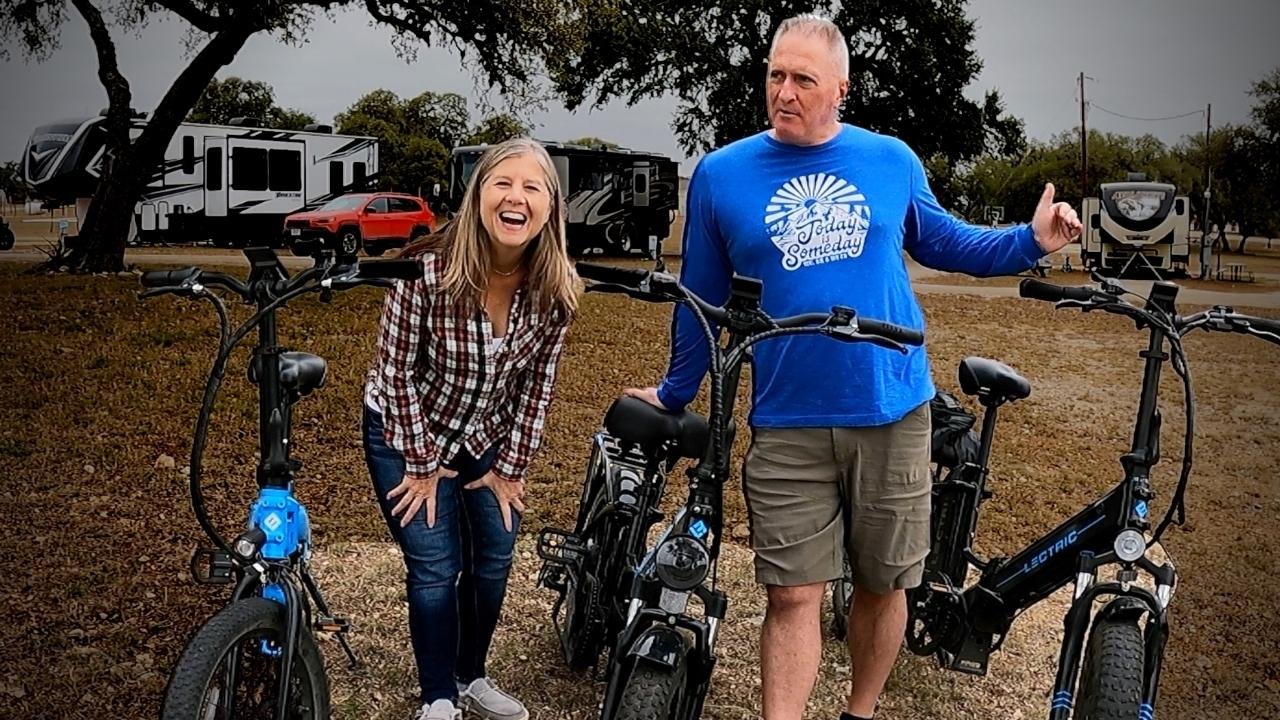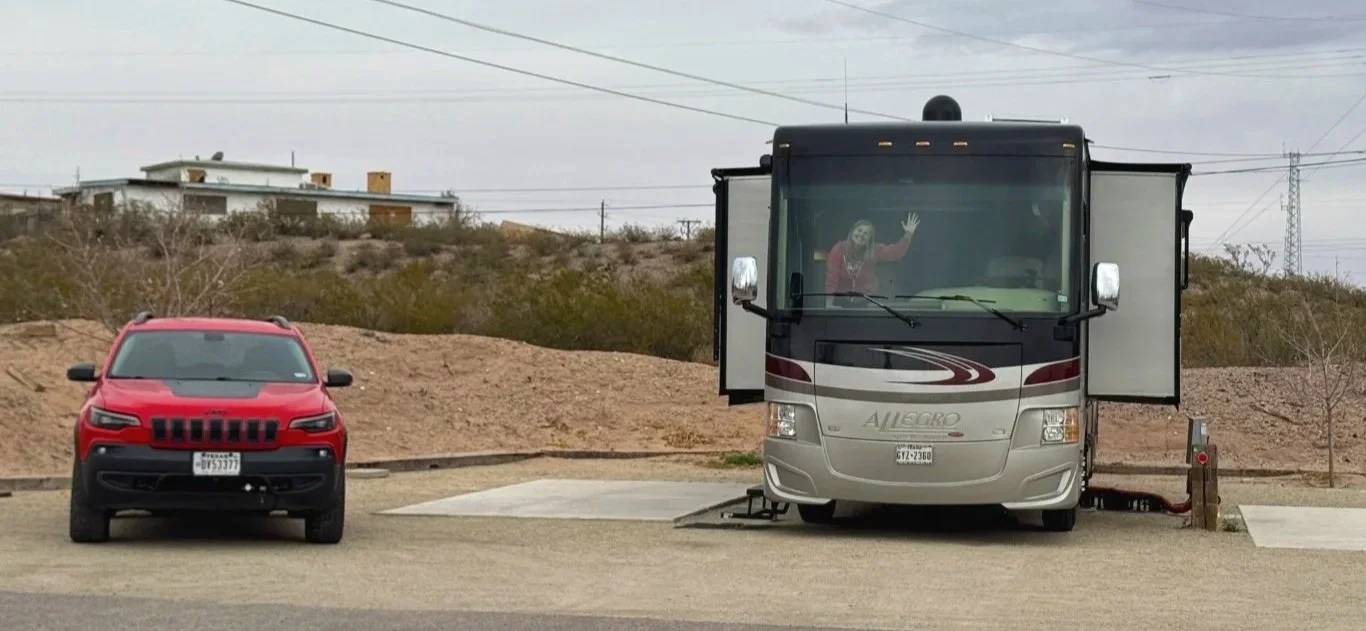Choosing an Ebike for RV Living
Disclosure: The links below may be affiliate links that are at no additional cost to you. When you use our links, we may earn some extra beer money, but it won’t be enough for Phil’s ice cream habit or a batch of Stacy’s famous margaritas (recipe here).
We’ve had our ebikes for over four years now and can’t imagine traveling without them. We love hopping on them to explore a city or trail. There are so many reasons to love them. But there is a lot to consider about ebikes before your purchase including where you can ride, safety and which bike is right for you. So let’s dive into a few of those topics now.
Benefits of Ebikes
Convenience
One of the main advantages of electric bikes they are convenient, easy to use, transport and store. You don’t have to worry about traffic jams or parking - just hop on the bike and go! They are much easier to ride than regular bicycles, as they require less effort and energy on the part of the rider. This makes them ideal for those who want to explore their location without the hills kicking their butts.
Cost-Effective Transportation
Electric bikes can be an incredibly cost-effective way to get around when you're traveling. You don’t have to worry about fuel costs or parking fees with an ebike.
Explore More Of Your Destination
Electric bikes allow you to explore more of your destination in less time than traditional bicycles or cars would allow. With an electric bike, you can travel faster than walking while still being able to take in all the sights and sounds along the way. People who have an ebike tend to go further and go faster than tradition bikes.
more can ride
Many believe electric bikes are only for riders looking for a shortcut. In truth, electric bikes can benefit many riders and scenarios, such as extra help while riding hills or recovering from an injury. An ebike allows people with many different abilities to hop on a go. Phil is a prime example. He was able to ride the ebke to explore Colorado right after his total knee replacement.
Environmentally Friendly
Electric bikes also provide environmental benefits that other modes of transport cannot match. They produce zero emissions and do not require gasoline or oil. Furthermore, since electric bikes are powered by electricity, they can help reduce our reliance on fossil fuels and carbon footprint.
Ebike Classifications
eBikes are available in three classifications, from Class 1 to Class 3. All electric bike classes are defined by their max speed and an electric power component.
Class 1: Tops out at 20 mph and uses pedal-assist technology to power the bike.
Class 2: Also tops out at 20 mph but uses a throttle to control the amount of electric output the bike produces.
Class 3: Produces speed up to 28 mph, utilizing pedal-assist technology only. Class 3 electric bikes are illegal in many states
Types of E-Bikes
Pedal-Assist
An electric bike powered by pedal assist will require the rider to pedal without exerting as much energy (leg power) compared to a regular bicycle. Electric bikes are perfect for those who enjoy riding a bike but want help when climbing hills or going longer distances. Most models are equipped with a setting that allows you to change the amount of help you receive while pedaling. You can also turn off the pedal assist completely.
Throttle-Powered
The throttle is mounted on the handlebar and can be activated by twisting a throttle or pressing a thumb lever. A throttle-powered electric bike does the rider to pedal the bike at all. Throttles make climbing those hills a breeze. This is Phil’s favorite mode, by the way! Most throttle ebikes will let you pedal without using the throttle.
combo
Our bikes have both the pedal assist and the throttle, which is what we prefer. It gives us more options as we ride through a city or trail.
choosing the right ebike
Choosing an electric bike can seem overwhelming. There are many different price points, styles, frame sizes, tire sizes, classes, battery sizes, and so many accessories! Whew! That is a lot. Before you buy test ride a few at a local bike shop or hop on a friends ebike. It’s the best way to see if you fit the bike before you buy. Let’s discuss some of the options to consider before you buy.
Range & Battery life
One of the most important things to consider when choosing an ebike is the range of the battery. How far do you plan on going between charges? If you plan to ride 50 miles you will need a longer battery than someone who rides 5 miles. What kind of terrain will you be riding in? The more rugged the terrain the more strain on the battery. These are all important questions that should influence your decision when it comes to range and battery life. Make sure you select an ebike with a range and battery life that take you as far as you want to go.
For more information on what affects battery life check out What Factors Affect the Range of an Electric Bike.
Speed & Power
Another key factor in selecting the right ebike is speed and power. The output for ebike motors range from 250 watts up to around 750 watts. If you need enough speed and power to keep up with traffic you will need more power than someone who plans a leisurely ride. Keep in mind that higher-powered ebikes tend to come with shorter battery ranges. Below are a few articles that may help you decide how much power you need.
Price & Features
Finally, price and features should also be considered when selecting the best ebike. Think about what features are most important to you — do you want something lightweight and portable, or do you want something rugged enough for off-roading? Do luxurious touches matter, or are more basic features sufficient? Knowing these things ahead of time will help narrow down your choices considerably, making it easier for you to find the perfect fit for your needs.
Where Can You ride
Electric bicycles offer a great way for travelers to explore their location while still remaining ecofriendly. But before you go and take one out for a spin, make sure you know where they’re prohibited first! By researching local and state regulations regarding e-bikes beforehand, you can ensure that your adventures remain safe and legal. Also be aware of parks and public land rules regarding ebikes. Ebike regulations vary by state and park, so it is always recommended to research before you ride.
We were planning to ride our ebikes on a city trail in Indiana. After a little research we quickly discovered they would impose a $2,500 fine if caught riding an ebike on that trail! We are so glad we looked it up before we packed up the bikes and and took them downtown. Luckily, we had our mountain bikes and were still able to enjoy the trail.
National Parks & Forests
As of 2020 all national parks and forests allow ebikes. However they have specific rules for ebikes. Check which trails ebikes are permitted on, where ebikes can be parked and what class of ebike can be used before you head out on your ride. You can always find detailed information on the website of your chosen park. The rangers station and visitors center will also have information on ebike rules. Below are a few resources that may be helpful.
wilderness areas
E-bikes are prohibited in federally designated wilderness areas located within national parks or forests. These areas are often protected by special laws that prohibit motorized vehicles from entering them so as to preserve their natural beauty and wildlife habitats. Again, it is important to check with the local authorities before planning your trip so that you can avoid any potential fines or other penalties associated with riding an e-bike in these locations.
Public Roads & Trails
In most states, riding an e-bike on public roads and trails is legal, provided it meets specific requirements such as having a maximum speed of 20 mph and a minimum weight of 100 lbs or less (depending on the state). However, some states have stricter regulations when it comes to operating an e-bike on public roads, including age and approved a bike helmet. As we’ve said before, familiarize yourself with the laws before riding your ebike out into traffic!
You can find more state ebike rules and regulations at Learn About the World of Electric Bikes.
prevent LITHIUM Battery explosions
NEVER leave your e-bike or battery UNATTENDED while charging
Never charge lithium batteries while you’re sleeping
Use the charger and power adapter specifically designed for your battery
Only use approved, unmodified battery replacement packs
Follow the manufacturer’s instructions for proper charging
Unplug the device when it’s done charging
Keep the battery away from flammable materials while in use, such as clothing or upholstery
Additionally, never throw your lithium-ion batteries in the trash or general recycling. Instead, take them to a local battery recycling facility or hazardous waste collection center.
our ebikes & Accessories
You will find our current ebikes HERE with all of our favorite ebike accessories.
The best ebike for rv living
Choosing an ebike is no easy task — there are so many factors to consider! But by focusing on type of bike needed, battery capacity/range, size and comfort features — you’ll be able to find the perfect ebike fit for your RV life! Whether you’re planning on taking short trips around town or long cross-country trips — finding the right ebike will help make RV life even more enjoyable!
GET MORE RV TRAVEL IDEAS, TIPS, UPDATES, DISCOUNTS, PERKS, AND MORE!
Phil & Stacy share weekly travel and RV articles to inspire and inform you. They also share discounts, sales, and freebies! So don’t miss out! Sign up for the newsletter below.
Recent Travel & RV blogs
Thanks for Stopping by!
Author: Phil, Today is Someday
All Rights Reserved, Copyright 2022













